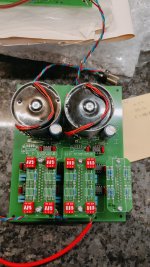The NXL550 R1.0 amplifier module is a high performance, hi end amplifier module capable of over 500 watts into 4 Ohms and is 2 Ohm and 1 Ohm stable for short periods (60 sec).
Directly driven from an OPA462 High Voltage Op Amp.
It features the option of adding separate regulated input/driver stage supplies for even high performance.
The current power measurements were done on a +-70vdc linear power supply, higher power outputs can be achieved with voltage supplies as high as +-75 volts and with other versions that are capable of handling DC power supplies as high as +-90 volts DC.
The main PCB has an over temperature and over current LED status Flag which also serves as an output clipping indicator.
Specifications:
8 Ohms: 245W per channel, powered from +-70vdc supply rails
4 Ohms: 425W per channel powered from +-70vdc supply rails
8 Ohms: 300W per channel, powered from +-80vdc supply rails
4 Ohms: 545W per channel powered from +-80vdc supply rails
Frequency Response: 20Hz-20Khz, -0.1db, 3Hz-210KHz, -3dB Input filter limited.
THD: 0.002%, 1khz, @200W into 8 ohms: 0.01% 10khz @200 Watts into 8 Ohms
IMD: 0.002%, @200W RMS into 8 ohms
SNR: -105dB, Unweighted, referenced to full output; -112.6dB A-Weighted
Damping Factor: 800 into 8 ohms, 100Hz
Gain: 22 (27dB) other gain options are available upon request?
Input Impedance: 22k Ohms Unbalanced:
Inputs: RCA Phono
Recommended Linear Voltage Supply +-70 Volts DC
For higher power output +-75vdc can be used.
PSU Power Transformer secondary windings 50vac (800VA)
Printed Circuit Board Dimensions 105mm x 72mm
Small form factor PCB
Captured Images Showing the following.
1Khz Sine Wave driving 8 Ohm load
1khz Square Wave response driving 8 Ohm load
10khz Clipping response driving 8 Ohm load
10khz Square Wave response driving 8 Ohm load

